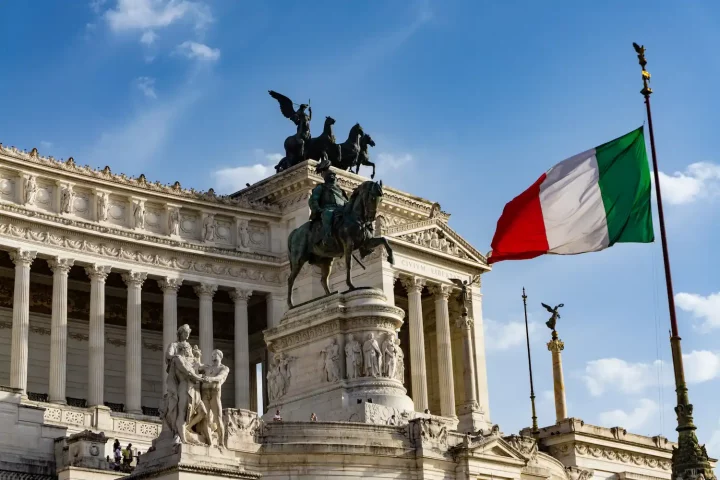The concept of Italian citizenship emerged with the unification of Italy in 1861. Before this, Italy was fragmented into multiple states, each with its own legal traditions and identity. The Law of March 17, 1861, proclaimed the Kingdom of Italy, laying the foundation for a unified national identity. However, formal citizenship laws were still undefined.
In 1865, Italy introduced its first Civil Code, influenced by Napoleonic legal principles. Under this framework, nationality was primarily based on descent (jus sanguinis), meaning Italian citizenship was transmitted by blood, rather than place of birth.
While other countries, like France and the United States, embraced jus soli (citizenship by birth within the territory), Italy remained committed to hereditary transmission, ensuring that Italian nationality was preserved across generations.
The 1912 italian citizenship law (Law No. 555) – reinforcing jus sanguinis
By the early 20th century, mass emigration became a defining feature of Italy’s demographic landscape. Millions of Italians left for North America, South America, and Europe, raising concerns about national identity and citizenship retention. In response, Italy enacted Law No. 555 of 1912, which formally strengthened jus sanguinis principles.
This law ensured that Italian descendants born abroad retained their citizenship, even if their parents were naturalized in another country, as long as this naturalization occurred after their birth. However, women faced citizenship transmission restrictions, as Italian nationality was only passed down through the male lineage.
Take advantage of specialized assistance to secure your passport for a borderless future.
The republic of Italy and the 1948 constitution – expanding rights
Following World War II, Italy transitioned into a republic, adopting its new Constitution in 1948. This marked a significant shift in legal and political structures, with greater emphasis on human rights and equality.
The 1948 Constitution, however, did not address the gender inequalities present in the 1912 citizenship law. These disparities were finally corrected in 1983, when the Italian Constitutional Court ruled the provision unconstitutional, affirming that children should have the right to inherit citizenship from either parent.
While a new law (No. 123/1983) ensured equal rights for women, it was not applied retroactively, leaving individuals born to Italian mothers before January 1, 1948 excluded from automatic recognition.
This led to the Ministry of the Interior seeking clarification from the Consiglio di Stato, which ruled that the equality principle only applies to children born after 1948, meaning Italian consulates and city halls continue to reject applications from maternal-line descendants born before that date.
Despite this restriction, the Italian Court of Cassation in 2009 expanded the interpretation, allowing judicial claims for citizenship transmission from pre-1948 maternal ancestors. However, due to Italy’s civil law system, the 1948 Rule is not considered binding case law, so consulates and city halls remain obligated to deny applications from descendants of pre-1948 Italian mothers.
As a result, individuals seeking citizenship through maternal lineage must apply directly to the Italian courts, where legal arguments based on gender equality precedents continue to challenge outdated restrictions.
Law No. 91 of 1992 – Modernization and dual citizenship
As global mobility increased, Italy modernized its nationality laws with Law No. 91 of 1992. This reform introduced dual citizenship, allowing Italians to retain their nationality even if they became naturalized in another country. Previously, foreign naturalization resulted in automatic loss of Italian citizenship, which significantly affected emigrants.
Decree-Law No. 36/2025 – contemporary restrictions
On March 28, 2025, Italy enacted Decree-Law No. 36/2025, introducing major restrictions on jus sanguinis citizenship. Historically, Italian citizenship recognition had no generational limits, allowing great-grandchildren and further descendants to apply.
However, the new law limits eligibility to individuals whose parent(s) or grandparent(s) were born in Italy. If an individual’s parents, but not grandparents, resided in Italy for at least two years, they may also qualify for citizenship under the eligibility criteria.
This law was controversial, as it retroactively regulates past nationality claims, contradicting established legal principles that laws should only govern future events. In fact, the Italian Constitutional Court has ruled in past cases that retroactive restrictions must be proportionate and reasonable.
Take advantage of specialized assistance to secure your passport for a borderless future.
Special cases and anomalies in Italian citizenship
Certain historical events have created unique exceptions in Italian nationality law. For instance, individuals from territories once part of the Austro-Hungarian Empire experienced complications due to border changes.
Additionally, the role of marriage in citizenship transmission evolved over time. Until 1983, foreign women who married Italian men automatically acquired citizenship. However, this privilege was later abolished, requiring spouses to undergo a naturalization process.
The impact of the Italian diaspora and current debates
In recent years, the demand for Italian citizenship by descent has surged, particularly among descendants of Italian emigrants in the United States, Brazil, and Argentina.
The approval of Law No. 74 of May 23, 2025, solidified the new limitations proposed by Decree–Law No. 36/2025, sparking intense legal and political debates. Critics argue that these reforms violate constitutional principles, particularly Article 3 (equality) and Article 25 (retroactivity) of the Italian Constitution. Affected applicants may seek judicial recourse, either through the Italian Constitutional Court or the European Court of Human Rights.
Italian nationality laws have evolved from flexible jus sanguinis principles to restrictive regulations, reflecting changing societal values and political priorities. While earlier reforms expanded citizenship rights—particularly dual nationality and gender equality—recent measures have tightened access, limiting generational eligibility and introducing administrative barriers.
As legal challenges unfold, the future of Italian citizenship by descent remains uncertain, with judicial rulings expected to shape how nationality is transmitted in the years ahead. Whether courts uphold or reject these restrictions, Italian nationality law will continue to evolve, balancing historical traditions with contemporary governance concerns.






